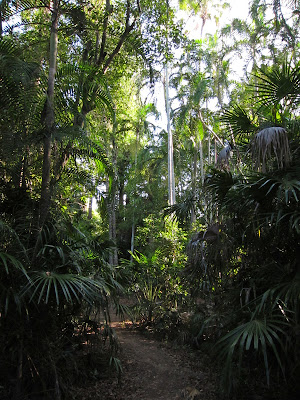Kakadu National Park comprises six main habitats: the monotonous savanna woodlands, floodplains and biilabongs, the southern hills and ridges (of which I had seen a little while visiting the rock art), the stone country (the Arnhem land plateau) , the tidal flats where the land meets the ocean in the north, and the monsoon forests. The latter form a tiny part of the total landscape, but intrigued me, and as there was a small monsoon forest with a marked walking trail close to Ubirr, one of the rock art sites that I visited, I decided to visit.
I was the first person to arrive at the car park in the morning – if you don’t count the pair of chicken like birds strutting around. They were sturdily built, and had small crests and orange legs and feet. I’d seen them before, but hadn’t been able to identify them. Like all the walking trails, Manngarre has an explanatory board at the beginning. It said that if I was lucky I might see two interesting bird species on the walk. The first was the orange-footed scrubfowl. Ah, so that’s what they were. And the other was the rainbow pitta. Apart from being a kind of bread, pittas are rainforest birds. In the bird books, they stand out in their bright colours, but in reality they are shy birds whose bright colours blend in with the dappled light. I set off along the trail, and rounded the first corner. There was a rainbow pitta in the middle of the track. It was kind enough to stay just long enough for me to change the lens on my camera and take one (not very good) photo. I saw two more later but fleetingly as they quickly hid in the vegetation.
I hadn’t gone much further when I was assaulted by the sound – and smell – of a roost of a hundred or so fruit bats. They were squabbling and bickering as fruit bats seem to.
The forest was very different from the savanna woodlands that I’d been driving through: more luxuriant and darker.
Animal life is always hard to find in rain forests, but I did see some butterflies:
The forest also contained a sacred aboriginal site. It’s a women’s site, and aboriginal men don’t go there, and notice boards ask that other men don’t visit either. The rainbow snake travelled to Ubirr where she left her shadow on the rock in the shape of a rainbow.
Later she changed into an old woman and came to the forest, where she rested during her menstrual period, before continuing across the river. While she rested she piled up sand around her which became a boulder, and her form is given by the roots of a banyan tree that are wrapped around the boulder. The site is known as “The old lady sits”.








Hi Kate,
ReplyDeleteYou said that the Rainbow Pitta bird wasn't a very good photo. I'd have been over the moon with a photo half as good :O). The bats are great too.
There's such a great history for everything as well.
It's a pity that your trip will eventually came to an end.
chp.